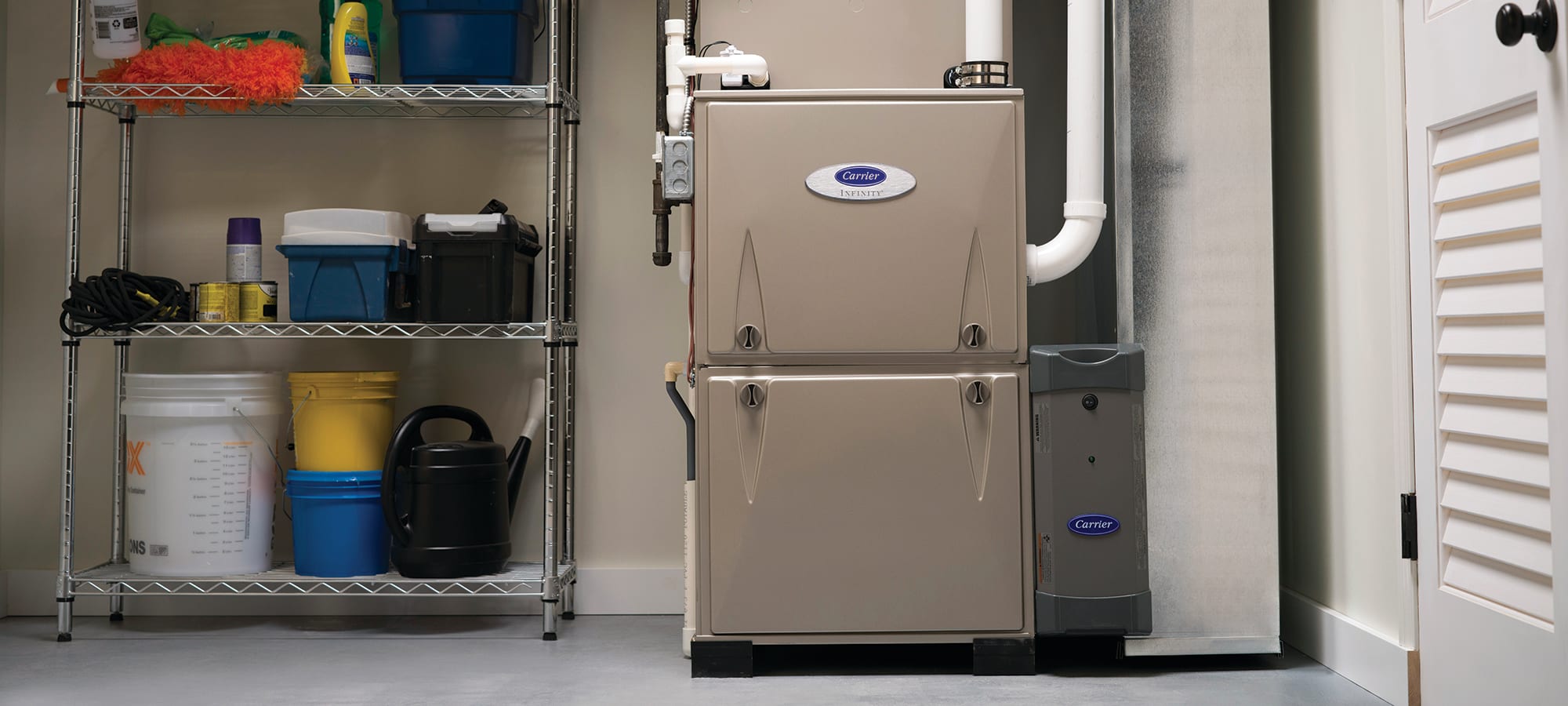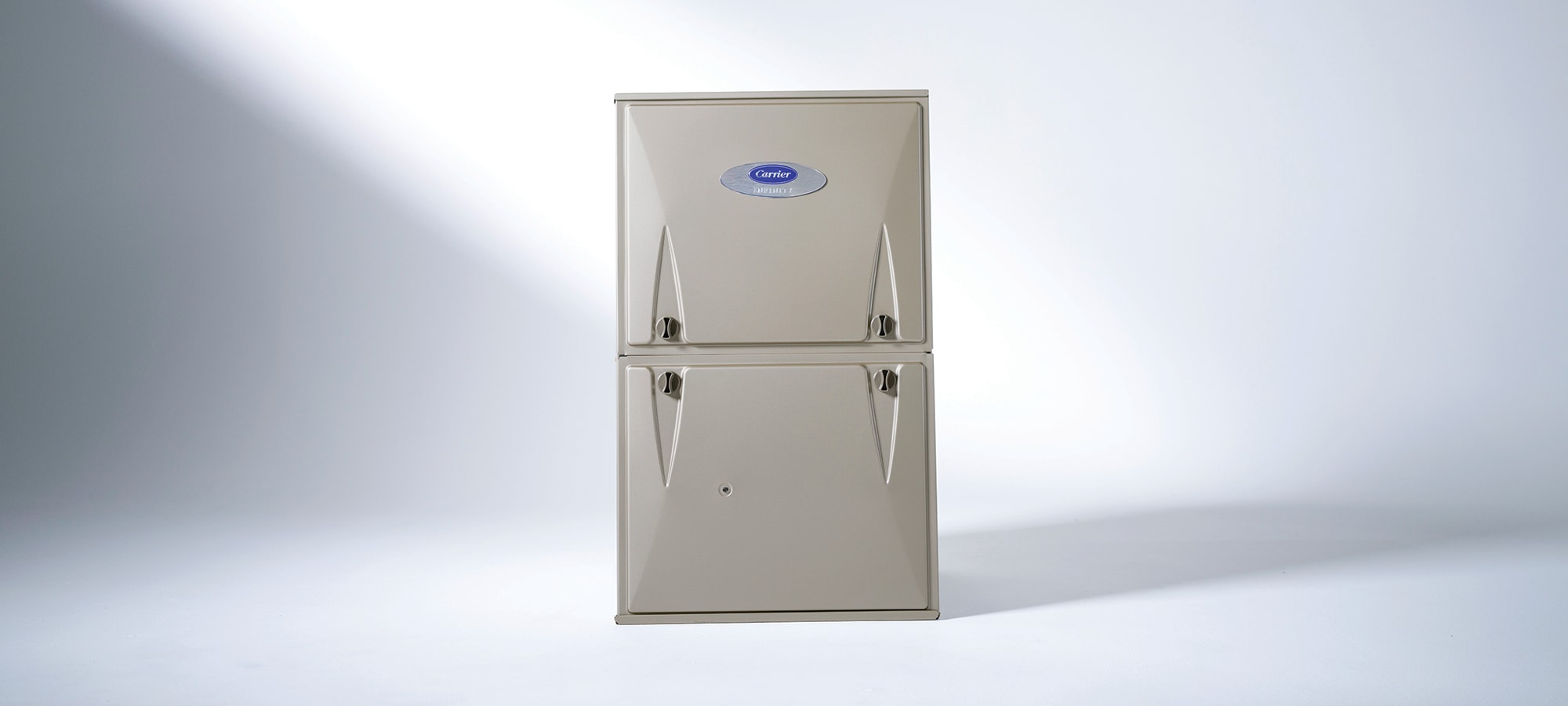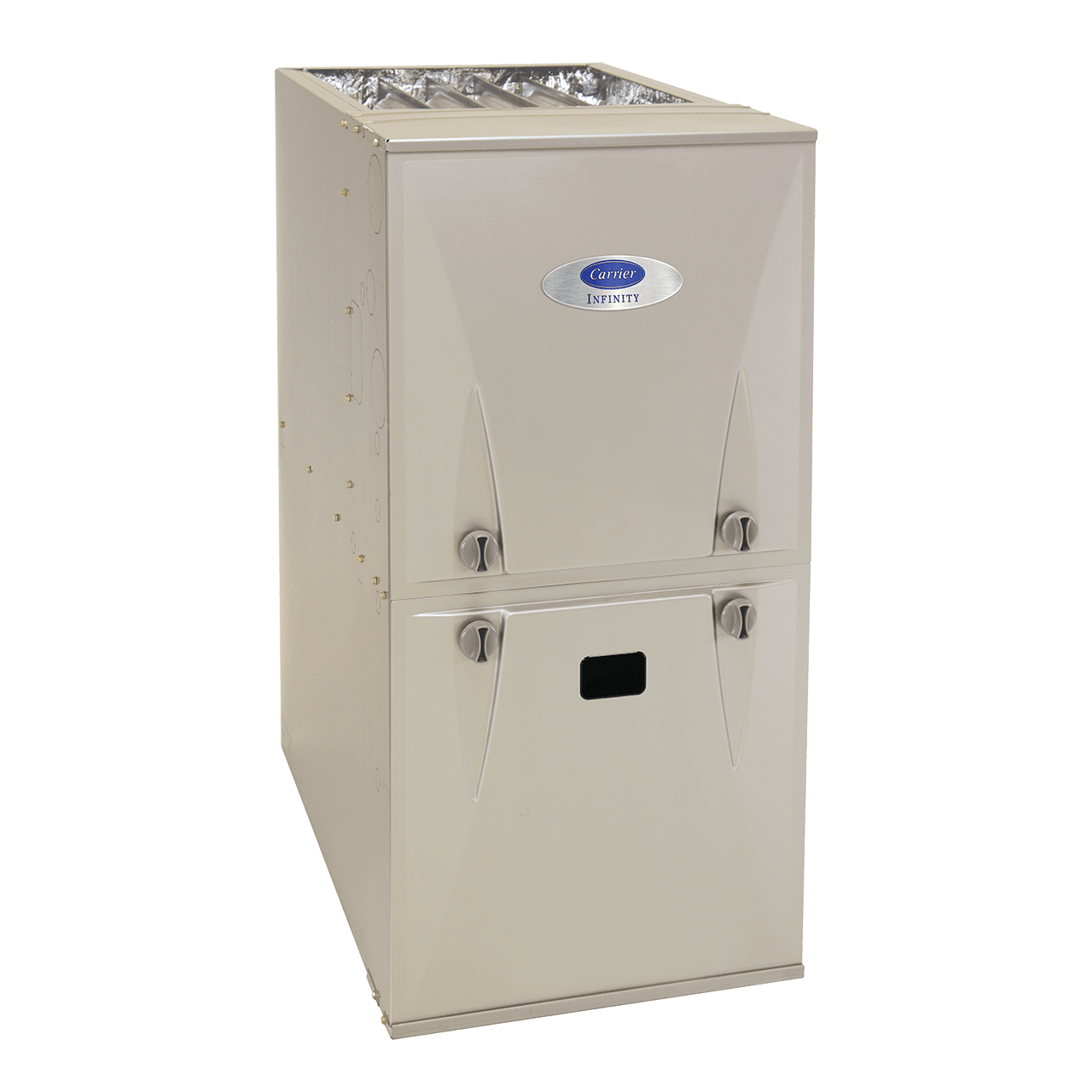Carrier Furnaces
Out of all of our HVAC products, the gas furnace is arguably one of the most important. The furnace is the heart of your home—out of sight, out of mind, and still keeping you and your family comfortable all year round. Our quiet, energy-efficient furnaces are designed to provide warmth to keep you cozy in winter and to circulate clean, refreshing air from your cooling system in the summer.

Compare Furnace Product Lines
|
|||||||
|
|||||||
|
|||||||
|
|||||||
|
|||||||
|
|||||||
|
|||||||
|
|||||||
|
|||||||
|
|||||||
ENERGY STAR® certified. Our highest efficiency and most advanced furnace with up to 98.5% AFUE for premium energy savings with excellent humidity control and premium comfort
Initial Cost $$$
Energy Savings:
Comfort Features:

ENERGY STAR® certified. Up to 96.7% AFUE for premium energy savings with enhanced comfort features.
Initial Cost $$$
Energy Savings:
Comfort Features:

ENERGY STAR® certified. Up to 97.0% AFUE for premium energy savings with enhanced comfort features.
Initial Cost $$$
Energy Savings:
Comfort Features:

Designed to meet California and Colorado regulations. 80% AFUE for moderate energy savings with standard comfort features.
Initial Cost $$$
Energy Savings:
Comfort Features:

80% AFUE for moderate energy savings with enhanced comfort features.
Initial Cost $$$
Energy Savings:
Comfort Features:

Designed to meet California and Colorado regulations. Up to 95% AFUE for enhanced energy savings with standard comfort features.
Initial Cost $$$
Energy Savings:
Comfort Features:

ENERGY STAR® certified. Up to 96.7% AFUE for premium energy savings with enhanced comfort features.
Initial Cost $$
Energy Savings:
Comfort Features:

ENERGY STAR® certified. Up to 97.0% AFUE for premium energy savings with enhanced comfort features.
Initial Cost $$
Energy Savings:
Comfort Features:

ENERGY STAR® certified. Up to 97% AFUE for premium energy savings with standard comfort features.
Initial Cost $$
Energy Savings:
Comfort Features:

80% AFUE for moderate energy savings with enhanced comfort features.
Initial Cost $$
Energy Savings:
Comfort Features:

Designed to meet California regulations. 80% AFUE for moderate energy savings with enhanced comfort features.
Initial Cost $$
Energy Savings:
Comfort Features:

80% AFUE for moderate energy savings with standard comfort features.
Initial Cost $$
Energy Savings:
Comfort Features:

Designed to meet California regulations. 80% AFUE for moderate energy savings with standard comfort features.
Initial Cost $$
Energy Savings:
Comfort Features:

All sizes ENERGY STAR® certified. Up to 97% AFUE for premium energy savings with standard comfort features.
Initial Cost $
Energy Savings:
Comfort Features:

Up to 92.1% AFUE for enhanced energy savings with standard comfort features.
Initial Cost $
Energy Savings:
Comfort Features:

80% AFUE for moderate energy savings with standard comfort features.
Initial Cost $
Energy Savings:
Comfort Features:

Designed to meet California regulations. 80% AFUE for moderate energy savings with standard comfort features.
Initial Cost $
Energy Savings:
Comfort Features:

80% AFUE for moderate energy savings with standard comfort features.
Initial Cost $
Energy Savings:
Comfort Features:

Designed to meet California regulations. 80% AFUE for moderate energy savings with standard comfort features.
Initial Cost $
Energy Savings:
Comfort Features:

Designed to meet California and Colorado regulations. 80% AFUE for moderate energy savings with standard comfort features.
Initial Cost $$
Energy Savings:
Comfort Features:

Designed to meet California and Colorado regulations. ENERGY STAR® certified. Up to 95% AFUE for enhanced energy savings with standard comfort features.
Initial Cost $$
Energy Savings:
Comfort Features:

Select sizes ENERGY STAR® certified. Up to 87.5% AFUE for moderate energy savings with enhanced comfort features.
Initial Cost $
Energy Savings:
Comfort Features:

Up to 86.4% AFUE for moderate energy savings with enhanced comfort features.
Initial Cost $
Energy Savings:
Comfort Features:

Up to 87.5% AFUE for moderate energy savings with standard comfort features.
Initial Cost $
Energy Savings:
Comfort Features:

Up to 86.4% AFUE for moderate energy savings with standard comfort features.
Initial Cost $
Energy Savings:
Comfort Features:
What to Look for in a Home Furnace
Comfort Features
When it comes to choosing a home furnace, we offer different options so you can decide what’s right for your comfort and your budget. A single-stage furnace with airflow on or off, provides the most basic level of comfort. A two-stage model offers you more control, with high- and low-stage heating options, and can provide more consistent comfort. Packed with our industry-leading climate control innovations, our modulating furnaces give you the most precise temperature control and best comfort features.
Humidity Control
Steady humidity levels in your home can dramatically improve your comfort. Pairing an Infinity furnace with a variable-speed air conditioner can provide our best humidity control during the summer and warm comfort during the winter.
Sound Performance
Furnaces with modulating and two-stage heating provide ultra-quiet operation compared to models with single-stage heating. In addition, models with fully insulated cabinets can further reduce noise levels. If your home furnace unit is located in a closet or near an occupied living space, sound performance might be an important feature to consider.
Energy Savings
Home furnaces are rated by their annual fuel utilization efficiency (AFUE). The AFUE rating of a furnace is much like miles per gallon (MPG) for a car: the higher the AFUE rating, the more energy-efficient the system. When factoring in energy costs over the lifetime of your furnace, buying an energy-efficient heating system can save a great deal of money in the long run. Carrier furnaces feature a multitude of energy efficient innovations that can help you to save on your heating bill while making green choices for the environment.
POWERFUL, PRECISION TECHNOLOGY FOR HOME FURNACES
If you could look under the hood of a Carrier gas furnace, you’d see what drives the performance: a serious commitment to precision technology and quality. Depending upon the model, you might find a modulating gas valve that can be adjusted up or down in 1% increments. Models with variable-speed blower motors and inducer motors can deliver consistent temperature control all year long and enhanced humidity control as a part of your air conditioning system. Our 90+% AFUE rating gas furnaces include two heat exchangers -- a primary heat exchanger that does most of the work and a secondary heat exchanger that wrings out additional heat for higher efficiency and comfort. And, for reliable start-up and heating operation, all models feature our patented PowerHeat™ igniter.
Additional comfort enhancing functions on select models include Ideal Humidity System® technology for relief from hot and sticky summer air and ComfortFan™ technology, which allows you to select furnace fan speeds from the Infinity System Control. Carrier furnaces can also be paired with energy-efficient heat pumps that help to move ambient heat as opposed to burning fuel. Carrier furnaces combine quality and performance in a durable, attractive and compact cabinet. And if the mention of “compact cabinet” prompts you to ask yourself, “What size furnace do I need?”, you’re in luck! Your local Carrier expert can properly size and install the furnace that makes the most sense for you.

Types of Furnace Heaters
When your search for new furnaces, keep in mind that not all models are created equally. Most forced air furnace models fall into two categories based on their fuel source -- natural gas furnaces or oil furnaces. And in most cases, the decision between natural gas or heating oil is already made for you based on the fuel source available for your home. If you can decide between a natural gas furnace or heating oil furnace, consider the cost differences between the furnace itself as well as the price of natural gas versus heating oil - typically, oil furnaces cost less to install up front, but the cost of using natural gas for fuel tends to be lower over time. Your up-front furnace cost may be a once every 10-15 years occurrence, while the fuel source will be an ongoing monthly cost. To learn more about the right furnace for your home, read Carrier’s full blog post on the different types of furnaces.
Condensing Gas Furnaces
All furnaces include a heat exchanger, which converts combustion gases into heat for your home. Condensing models employ a secondary heat exchanger which squeezes additional heat from combustion gases to achieve 90% or better AFUE efficiency. Most standard models with one heat exchanger deliver around 80% AFUE efficiency.
Can CARRIER FURNACES USE PROPANE?
Many of the Carrier gas furnaces currently available can be converted for use with propane. The process includes replacing burner orifices, installing spoiler screws, installing a low gas pressure switch and making several additional adjustments. This is a job for your local, professional Carrier HVAC expert, and definitely not for the average home DIYer. To learn more about propane furnaces and furnace conversions, read our full article on propane furnaces.
Furnace Stages
Today’s forced-air furnaces are available in single-stage, two-stage or multi-stage models. Think of heating stages as gears on a bicycle or a car. Single-stage models are like a bicycle with one gear. It’s great on a flat stretch of road, but takes a lot more energy to go up a steep hill - or in this case, to heat your home to your ideal temperature. Two-stage models add a second gear, one to handle everyday heating needs, and a second gear to provide additional heating as needed. Multi-stage, or modulating stage furnaces are like cruise control on your car, adjusting up and down as needed to provide comfort and efficiency as weather conditions change.
Carrier Furnaces for Any Home – Any Budget
When you turn to the Carrier experts for your home heating system needs, you’ll find a comprehensive selection of natural gas and oil furnaces packed with home comfort innovations, and designed to fit any home and nearly any budget. Of course, the cost of a new furnace often reflects the comfort benefits, performance and length of warranties. For those who enjoy the best of the best, our premium, Infinity® series models deliver the highest efficiency and the most innovative comfort features we offer, quieter operation, and enhanced summertime humidity control as part of your home air conditioning system - including Greenspeed intelligence, which uses variable speed blower technology to automatically adapt your furnace to fit your home’s needs..
If you like premium perks at a more modest price, our Performance™ series models deliver the best of both worlds. If you are cost-conscious, our more budget-friendly Comfort™ series units can still achieve high efficiency with all of the built-in quality, support and backing of the inventor of modern air conditioning – Carrier.

High Efficiency Home Furnaces
You can compare furnace efficiency among models from different manufacturers using the furnace AFUE rating -- the higher the AFUE, the better the efficiency. Current high efficiency furnaces can be rated up to 98.5% AFUE, which can reduce utility costs over the life of the furnace and qualify the homeowner for furnace tax credits. In many cases, our Carrier high efficiency furnaces also include technology that can produce enhanced comfort benefits and quieter operation as well.
Whether you’re looking to buy a brand new furnace or you’re replacing a new furnace that is coming to the end of its lifespan, Carrier has the perfect heating solution for your home. Take a look at our buyer’s guide for furnaces and contact your local Carrier dealer for expert advice.
FREQUENTLY ASKED QUESTIONS ABOUT FURNACES
Learn More About House Furnaces
- How Much Does it Cost to Replace vs Repair a Furnace?
- Guide to Gas Furnaces
- Furnace Repair & Service
- How Do Gas Furnaces Work?
- Discover the importance of furnace maintenance
- Cost Of A Gas Furnace
- Gas Furnace Replacement
- Read about gas furnace repair
- Learn about furnace installation
- What is a high-efficiency gas furnace and how can it benefit me?
- 10 things to consider when buying a furnace
- Furnace troubleshooting tips
- Learn what to do if your furnace is leaking water
- How long does a furnace last?
- Comparing types of furnaces
- AFUE Rating (Annual Fuel Utilization Efficiency)
- Evaluating a Heat Pump vs Furnace
- Burning Smell in House? Causes and How to Fix It
- Learn the causes of a furnace not kicking on
- Learn about different HVAC system types
- Learn about furnace orientations: Upflow furnace, downflow furnace, and horizontal furnace


